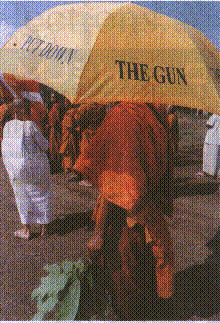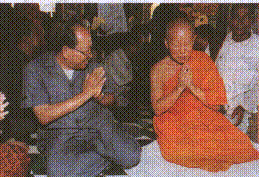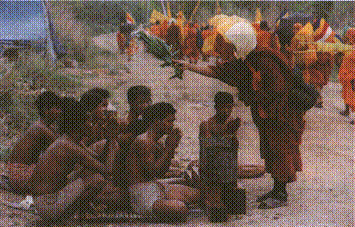Phnom Penh Post
April 17, 1997
The Dhammayietra Peace Walk
The Walk Goes On
By TRICIA FITZGERALD
MORE than twenty years after Khmer Rouge radicals banned religion and forced monks from their serene pagoda on the hills of Pailin, 230 Buddhist peace marchers emerged from the forest and entered the former rebel base.
After failing to reach Pailin in 1994 because of fighting, the Dhammayietra peace walk, the sixth led bv the venerable Buddhist monk Maha Ghosananda --finally crossed old front lines into
the former Khmer Rouge zone, of the north west. Saffron-clad monks, white-robed nuns and a handful of foreign peace activists, who had threaded their way from Battambang through heavily mined bamboo forests, arrived in Pailin Mar 25, and were warmly welcomed.
In Pailin alone, hundreds of former rebel fighters and their families, decked out in their best and brightest, hovered uncertainty along roads to welcome the march, offering gifts of food, candles and money to the weary walkers.
Waiting to be sprinkled with water and blessed by Ghosananda and the Dhammayietra monks, Pailin locals said they were ready for peace and Buddhism.
"We are very happy to see the Maha Ghosananda and the Dhammayietra here because it means the war is really finished and we can settle down to a better life," said Chai Ly, 44, who owns a bamboo shop 1Okm north of Pailin. "In the past we had to move often to the forest to avoid shelling, now the development is starting we are building houses, roads and gardens," Ly said.
Saffron-clad monks, white-robed nuns and a handful of foreign peace activists, who had threaded their way from Battambang through heavily mined bamboo forests, arrived in Pailin Mar 25, and were warmly welcomed.
In Pailin alone, hundreds of former rebel fighters and their families, decked out in their best and brightest, hovered uncertainty along roads to welcome the march, offering gifts of food, candles and money to the weary walkers.
Waiting to be sprinkled with water and blessed by Ghosananda and the Dhammayietra monks, Pailin locals said they were ready for peace and Buddhism.
"We are very happy to see the Maha Ghosananda and the Dhammayietra here because it means the war is really finished and we can settle down to a better life," said Chai Ly, 44, who owns a bamboo shop 1Okm north of Pailin. "In the past we had to move often to the forest to avoid shelling, now the development is starting we are building houses, roads and gardens," Ly said.
Former Khmer Rouge Foreign Minister Ieng Sary, whose radical 1975-79 government is believed to have eliminated thousands of Buddhist monks, welcomed Ghosananda and his followers into Pailin.
The meeting between the Nobel peace prize nominee and the now pardoned but still notorious rebel leader was brief. Ghosananda sprinkled water from a plastic bottle on a respectful Sary but paid
him no special attention.
Both leaders then made their way into Pailin's Wat Kong Kang, which is perched on a hill on the outskirts of town, for a short prayer session.
On the following day at least 1,000 Pailin residents gathered along roads for a personal blessing from Maha Ghosananda, who completed a 45-minute circuit of the town, leaving many people
still bowing in his wake.
"We have only 90 percent peace now...the other 10 percent is the remaining hard line Khmer Rouge, land mines and unresolved differences between people," Maha Ghosananda told reporters, the
latter an apparent reference to political conflicts degging the coalition government.
Pailin officials, who had spread the word of the walk's arrival, bustled along ahead of Maha Ghosananda, advising locals how to behave but a tiny minority stared from the shadows of their
houses and did not join in.
An official Pailin welcoming ceremony for the Dhammayietra which followed fell short of exptations, when Ieng Sary and Pailin Governor Ee Chhean, failed to attend, pleading personal and
family illnesses.
Once underway, the ceremony was punctuated by the sound of mines being detonated on the road into Pailin but in a rare occurrence, 24 hour a day grinding gem mining equipment was silenced.
Plans to release birds of peace at the ceremony were canceled as officials said they had been unable to catch and bring in the birds from either Battambang or Thailand.
Sary, who held a press conference near the welcoming ceremony immediately afterward Ghosananda left, said, the arrival of the venerated monk into his zone would re-inforce Cambodia's
peace process.
"When we welcome the Dhammayietra we are reinforcing the peace process, which has already begun, by educating the people that Cambodia will not survive as a nation [unless there is
peace]," Sary said. Sary, reiterated his claim that as a key figure in the Khmer Rouge regime, he had been powerless and that he was not responsible for the rebel's excesses "I did not show outwardly that I was a Buddhist but in my heart I remained a Buddhist secretly,"
Ieng Sary told reporters, adding that he had left a Budhist pagoda as a teenager, disillusioned with religion. "I have no guilt in my mind...did not give the order to stop religion and destroy the pagodas," he said.
Locals, who traveled from surrounding villages to greet the peace walk, said they were grateful that after almost 20 years without monks and religion in Pailin, Buddhism was making a come
back. "Pol Pot didn't like the monks," said Choun Heng, a 64 year-old Pailin grandmother, recalling the execution and removal of monks from pagodas around the country during Pol Pot's extremist regime.
"I am very happy for my grandchildren to see this walk. I think in the future many people here will practice [Buddhism],"Heng said. Former rebel military commanders in Pailin said around
two dozen monks had infiltrated the bamboo curtain and settled in Pailin in 1991, only to be disrobed and forced out of the zone, under new orders from Son Sen in 1995.
Monks and religion have been tolerated in Pailin and the neighboring breakaway rebel zones, since guerrillas loyal to Sary broke with Pol Pot in August 1996 officials said. Surprise guest at the Pailin proceedings was Sam Rainsy, who appeared unannounced Mar. 26, to walk around 15km of the Dhammayietra accompanied by a fleet of bodyguards.
Rainsy who met with aide to leng Sary, Long Narin, and the deputy military commander, Seng Narin, said he had joined the march, in Pailin, for "symbolic peace" reasons.
"I reminded them 1 have always been an advocate of peace and that I was one of the only MPs who opposed the bill outlawing the Khmer Rouge in 1994," Rainsy said, after the meeting.
Rainsy chided Cambodia's two Prime Ministers for not attending the walk, saying "it would have been meaningful if all political parties had joined with Cambodian people on this march, but they [Hun Sen and Ranariddh don't care," he added.
Emotional welcomes for the march and what it represented seemed to get stronger, the further the Dhammayietra pushed north.
In the former battle site village of Sala Krao, lines of school children gathered along the dusty road as streams of villagers poured in to welcome the walk. News that the Dhammayietra was coming, spread fast into Front 250 territory north of Pailin and up into Phnom Malai, 130km north of Pailin where the march was due to have arrived at press time.
The march will then continue to move steadily north of Malai, and is due to arrive at Banteay Chmar temple in northern Ba nteay Meanchey Apr 13.
News that the Dhammayietra was coming, spread fast into Front 250 territory north of Pailin and up into Phnom Malai, 130km north of Pailin where the march was due to have arrived at press time.
The march will then continue to move steadily north of Malai, and is due to arrive at Banteay Chmar temple in northern Ba nteay Meanchey Apr 13.





